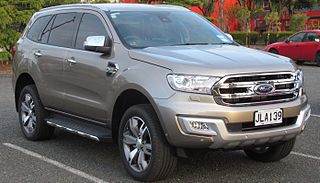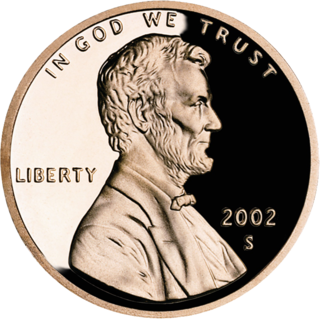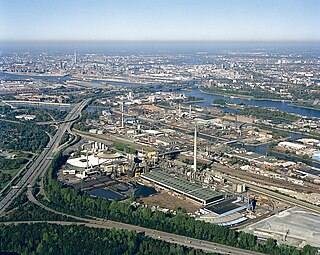
Rust is an iron oxide, a usually reddish-brown oxide formed by the reaction of iron and oxygen in the catalytic presence of water or air moisture. Rust consists of hydrous iron(III) oxides (Fe2O3·nH2O) and iron(III) oxide-hydroxide (FeO(OH), Fe(OH)3), and is typically associated with the corrosion of refined iron.

Zinc is a chemical element; it has symbol Zn and atomic number 30. It is a slightly brittle metal at room temperature and has a shiny-greyish appearance when oxidation is removed. It is the first element in group 12 (IIB) of the periodic table. In some respects, it is chemically similar to magnesium: both elements exhibit only one normal oxidation state (+2), and the Zn2+ and Mg2+ ions are of similar size. Zinc is the 24th most abundant element in Earth's crust and has five stable isotopes. The most common zinc ore is sphalerite (zinc blende), a zinc sulfide mineral. The largest workable lodes are in Australia, Asia, and the United States. Zinc is refined by froth flotation of the ore, roasting, and final extraction using electricity (electrowinning).

Corrosion is a natural process that converts a refined metal into a more chemically stable oxide. It is the gradual deterioration of materials by chemical or electrochemical reaction with their environment. Corrosion engineering is the field dedicated to controlling and preventing corrosion.

Cathodic protection is a technique used to control the corrosion of a metal surface by making it the cathode of an electrochemical cell. A simple method of protection connects the metal to be protected to a more easily corroded "sacrificial metal" to act as the anode. The sacrificial metal then corrodes instead of the protected metal. For structures such as long pipelines, where passive galvanic cathodic protection is not adequate, an external DC electrical power source is used to provide sufficient current.

Group 12, by modern IUPAC numbering, is a group of chemical elements in the periodic table. It includes zinc (Zn), cadmium (Cd), mercury (Hg), and copernicium (Cn). Formerly this group was named IIB by CAS and old IUPAC system.

A zinc–air battery is a metal–air electrochemical cell powered by the oxidation of zinc with oxygen from the air. During discharge, a mass of zinc particles forms a porous anode, which is saturated with an electrolyte. Oxygen from the air reacts at the cathode and forms hydroxyl ions which migrate into the zinc paste and form zincate, releasing electrons to travel to the cathode. The zincate decays into zinc oxide and water returns to the electrolyte. The water and hydroxyl from the anode are recycled at the cathode, so the water is not consumed. The reactions produce a theoretical voltage of 1.65 Volts, but is reduced to 1.35–1.4 V in available cells.

The Ford Everest is a mid-size SUV produced by Ford Motor Company since 2003. Developed and destined mainly for the Asia-Pacific region with production centered in Thailand, the first-generation Everest is based on the Mazda-based Ford Ranger pickup truck, while the following generations are based on the globally-marketed T6 Ranger. Unlike the Ranger which was paralleled with the Mazda B series or BT-50 until 2020, the Everest has no Mazda equivalent, as it was seen as unfitting for the brand.

A Mason jar, also known as a canning jar, preserves jar or fruit jar, is a glass jar used in home canning to preserve food. It was named after American tinsmith John Landis Mason, who patented it in 1858. The jar's mouth has a screw thread on its outer perimeter to accept a metal ring or "band". The band, when screwed down, presses a separate stamped steel disc-shaped lid against the jar's rim.

A zinc–carbon battery (or carbon zinc battery in U.S. English) is a dry cell primary battery that provides direct electric current from the electrochemical reaction between zinc (Zn) and manganese dioxide (MnO2) in the presence of an ammonium chloride (NH4Cl) electrolyte. It produces a voltage of about 1.5 volts between the zinc anode, which is typically constructed as a cylindrical container for the battery cell, and a carbon rod surrounded by a compound with a higher Standard electrode potential (positive polarity), known as the cathode, that collects the current from the manganese dioxide electrode. The name "zinc-carbon" is slightly misleading as it implies that carbon is acting as the oxidizing agent rather than the manganese dioxide.

Jarden was an American consumer products company. Formed by the spin out of Ball Corporation's canning business, the company became a wider conglomerate of consumer brands, particularly in the outdoors and home appliances market. Jarden was acquired in 2016 by Newell Rubbermaid, which renamed itself Newell Brands.

A debate exists within the United States government and American society at large over whether the one-cent coin, the penny, should be eliminated as a unit of currency in the United States. The penny costs more to produce than the one cent it is worth, meaning the seigniorage is negative – the government loses money on every penny that is created. Several bills introduced in the U.S. Congress would have ceased production of pennies, but none have been approved. Such bills would leave the five-cent coin, or nickel, as the lowest-value coin minted in the United States.

Mahle GmbH is a German automotive parts manufacturer based in Stuttgart, Germany. It is one of the largest automotive suppliers worldwide. As a manufacturer of components and systems for the combustion engine and its periphery, the company is one of the three largest systems suppliers worldwide for engine systems, filtration, electrics, mechatronics, and thermal management. In 2018, Mahle's sales amounted to over €12.5 billion.

Aurubis AG is a global supplier of non-ferrous metals and one of the world's largest copper recyclers. The company processes complex metal concentrates, scrap, organic and inorganic metal-bearing recycling materials and industrial residues into metals. Aurubis produces more than 1 million tons of copper cathodes per year and from these a variety of products such as wire rod, continuous cast shapes, profiles and flat rolled products in copper and copper alloys. Aurubis also produces a range of other metals, including precious metals such as selenium, lead, nickel, tin and zinc. The portfolio also includes other products such as sulfuric acid and iron silicate.
Copper zinc water filtration is a high-purity brass water filtration process that relies on the redox potential of dissolved oxygen in water in the presence of a zinc anode and copper cathode. It uses dissolved impurities within water as constituent substrate, which are reduced to more physiologically inert compounds.

The automotive industry in Japan is one of the most prominent and largest industries in the world. Japan has been in the top three of the countries with the most cars manufactured since the 1960s, surpassing Germany. The automotive industry in Japan rapidly increased from the 1970s to the 1990s and in the 1980s and 1990s, overtook the U.S. as the production leader with up to 13 million cars per year manufactured and significant exports. After massive ramp-up by China in the 2000s and fluctuating U.S. output, Japan is currently the third largest automotive producer in the world with an annual production of 9.9 million automobiles in 2012. Japanese investments helped grow the auto industry in many countries throughout the last few decades.
Zinc flake coatings are non-electrolytically applied coatings, which provide good protection against corrosion. These coatings consist of a mixture of zinc and aluminium flakes, which are bonded together by an inorganic matrix.
Dörken MKS-Systeme ) is an international specialty chemical company headquartered in Herdecke, Germany. It is the European market leader for micro-layer corrosion protection systems and is represented in more than 150 countries worldwide.
Americans for Common Cents is an organization based in Washington, D.C. that lobbies in favor of keeping the United States penny in circulation. It was established in 1990. The organization has conducted surveys and organized advertising campaigns in support of the continuing production of the penny. Its executive director, Mark Weller, has argued that eliminating the penny would lead to retailers rounding prices mainly up, not down, leading to inflation, but has offered little evidence to support this assertion.

VDM Metals Group based in Werdohl, Germany, is a manufacturer of corrosion-resistant, heat-resistant and high-temperature nickel alloys, cobalt and zirconium alloys as well as high-alloyed special stainless steels. These materials are used in the chemical process industry, the oil and gas industry, aerospace, automotive and electronics / electrical engineering. VDM Metals operates production sites in Germany and the United States. The company employs about 2,000 people worldwide.

Aluminium-based nanogalvanic alloys refer to a class of nanostructured metal powders that spontaneously and rapidly produce hydrogen gas upon contact with water or any liquid containing water as a result of their galvanic metal microstructure. It serves as a method of hydrogen production that can take place at a rapid pace at room temperature without the assistance of chemicals, catalysts, or externally supplied power.














